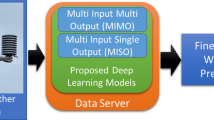Abstract
This paper introduces a new structure in neural networks called TD-CMAC, an extension to the conventional Cerebellar Model Arithmetic Computer (CMAC), having reasonable ability in time series prediction. TD-CMAC, the conventional CMAC and a classical neural network model called Multi-Layer Perceptron (MLP) are simulated and evaluated for 1-hour-ahead prediction and 24-hour-ahead prediction of carbon monoxide as one of primary air pollutants. Carbon monoxide data used in this evaluation were recorded and averaged at Villa station in Tehran, Iran from October 3rd. 2001 to March 14th. 2002 at one-hour intervals. The results show that the errors made by TD-CMAC is fewer than those made by other models.
Similar content being viewed by others
References
Albus, J. S., A new approach to manipulator control: The cerebellar model articulation controller (CMAC). Trans. of the ASME. Journal of dynamic systems, measurement and control: 220–227, 1975
Albus, J. S., Theoretical and experimental aspects of a cerebellar model. University of Maryland, 1972 Boznar, M., Pattern selection strategies for a neural network-based short term air pollution prediction model. au]Proceedings of intelligent information systems, IIS’97, IEEE Computer society: 340–345, 1997
Cotter, N. E., T. J. Guillerm, The CMAC and a theorem of Kolmogorov, Neural networks, 1(5): 221–228, 1992
Fernández de Castro, B. M., J. M. Prada-Sánchez, W. González-Manteiga and M. F. Bande, Prediction of SO2levels using neural networks. Journal of the air and waste management association, 53(5): 532–539, 2003
Gonzalez-Serrano, F. J., A. R. Figueiras-Vidal and A. Artes-Rodriguez, Fourier analysis of the generalized CMAC neural network. Neural Networks, 1(11): 391–396, 1998
Haase, P. and U. Schlink, Non-parametric short-term prediction of ozone concentration in Berlin. Paper presented at the air pollution modeling and simulation conference, Paris, 2001
Hornik, K., M. Stinchcombe and H. White, Multilayer feedforward networks are universal approximators. Neural networks, 2(5): 359–66, 1989
Miller, W. T., B. A. Box and J. M. Glynn, Design and implementation of high speed CMAC neural network using programmable CMOS logic cell arrays. IEEE conference on neural information processing systems-natural and synthetic, 1990
Pollack, A. K. and T. S. Stocking, General linear models approach to estimating national air quality trends. Systems applications. Inc., San Rafael, California (SYSAPP-89/098), 1989
Sarmadi, N. and M. Teshnehlab, Short-term weather forecasting using CMAC Structure, 20th. IASTED International conference applied informatics,Innsbruck, Austria: 284–351, 2002
Shumway, R. H. and D. S. Stoffer, Times series analysis and its applications. Springer-Verlag, 2000
Author information
Authors and Affiliations
Corresponding author
Rights and permissions
About this article
Cite this article
Abbaspour, M., Rahmani, A.M. & Teshnehlab, M. Carbon monoxide prediction using novel intelligent network. Int. J. Environ. Sci. Technol. 1, 257–264 (2005). https://doi.org/10.1007/BF03325840
Published:
Issue Date:
DOI: https://doi.org/10.1007/BF03325840




